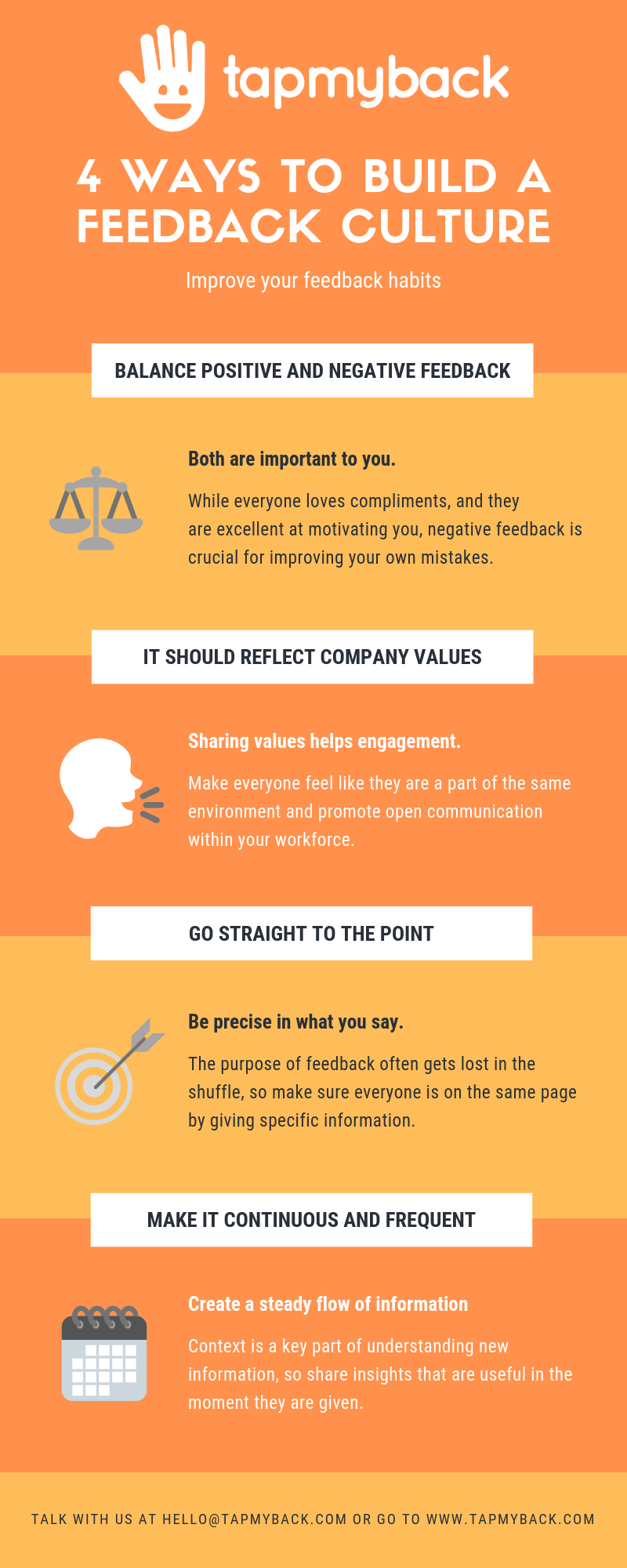How to create a good Feedback Culture [Infographic]
2022-10-10
Building a good feedback culture is a difficult task for most organizations. We reflected on why that happens and what can be done to improve that.
Sharing feedback is hard sometimes, let's just face the facts. It can be an awkward experience if your organization doesn't share the values as you and therefore has a different vision of what should and shouldn't be said. So to have an environment where you feel free to share those insights is important for both managers and employees alike. A feedback culture that can motivate your entire workforce. After all, we all seek to improve every day with each other, and we can't do that if we restrain ourselves from others' vision of us.
In that sense, it's important to talk about the culture of an organization as a facilitator of an open feedback environment. If everyone in your workplace values opens communication and the benefits it can bring, then you will start to build better feedback habits. That is essentially what implementing a feedback culture is all about.
Organizations with a strong feedback culture have a more engaged workforce and have better talent retention. Good feedback helps you build stronger relationships based on honesty and growth. So how can you build toward a feedback culture and improve employee engagement?
Let's start by defining the main issue at hand.
What is Feedback Culture
A culture built around feedback is one where everybody feels at ease with sharing and gathering important insights about themselves and others. Being comfortable to share that kind of information is important for anyone, regardless of position within an organization. So having a feedback culture requires a good level of awareness of what others expect from you and vice versa.
It's a flow of natural honest feedback that every organization can benefit from. Not having that kind of open feedback culture may be easier, but it prevents real growth within your team. Many organizations prefer more traditional methods like annual performance reviews that limit what you can effectively do with the feedback. A growth-minded feedback culture allows you to take value from your employee's insights.
In its nature, it's adopting habits that can improve the feedback flow in a certain workplace. Many organizations never build one because they don't know how to implement those habits. Building a good feedback culture requires a high level of commitment to giving good helpful feedback.
How can you build a good Feedback Culture?
Starting from the willingness to openly share and gather feedback, what you need to do is essentially make everyone feel like they are a part of the same environment. Promoting that kind of openness helps everyone feel connected through peer-to-peer feedback. The constant flow of information is a defining characteristic of a healthy feedback culture.
That information needs to balance in order to reflect a complete view of your workforce. Both positive and negative feedback are helpful in their own way. While you might associate the feedback with a more negative outlook, positive feedback is a great way of recognizing someone for their efforts, contributing to overall employee engagement. Negative feedback helps you be aware of areas of improvement.
Sharing the same values and practices is also a vital factor in building any sustainable culture. In terms of feedback, there are several key components to it. Feedback needs to be honest, straight to the point, balanced and fair. That way, as a habit, it helps you understand what needs to change or what needs reinforcement.
Once sharing feedback really becomes a habit, it will be more continuous and more consistent. Periodic feedback isn't helpful in that way since it lacks healthy monitoring of progress. Continuous helpful feedback is fundamental to maintaining a good feedback culture. When you have constant constructive insights you are more able to build a sustainable feedback culture in your organization.
What are the benefits of a Feedback Culture?
Having the need for constant feedback is a healthy habit. With strong feedback habits, you have a steady method to grow and improve on your past mistakes. Without that, you can't really know where you can improve and how. This is why establishing a good feedback culture is so important for managers and employees alike. All levels of an organization can benefit from a constant flow of feedback in several key areas.
- It increases engagement. When you are willing to open up to others about your problems you feel another level of connection with your workplace and your team. You feel more comfortable and more motivated.
- It helps with talent retention. Being comfortable enough to share different insights on your work helps you enjoy your workplace. That way, employees will feel as if they belong there.
- Establishes a better workplace environment. If an organization frequently recognizes their employees, they are offering a better work situation.
- It doesn't delay important subjects. Sometimes, feedback needs to be shared in a specific context, so delaying that may hurt the value of those insights. Constant feedback changes that, as you can get helpful information every day.
- Leads to overall better performance. If you have a steady flow of information about your performance and attitude you can improve in an easier fashion. Feedback is a powerful tool because it can lead us to a better situation.
Each organization will know which benefits can better help its workforce reach its goals. It's up to you as a manager to evaluate how can a feedback culture impact your work.
Practical Examples
A feedback culture can impact your daily routine in several different ways. It affects an organization at all levels, so it's easy to see in which situations feedback has an integral part. It's important to see how those situations translate in a practical manner.
1 - Don't rely on middlemen.
Imagine that you have a situation where someone shares your feedback about someone else. You, in that situation, are the middleman in a conversation that you shouldn't be participating in that manner. Feedback should be given directly to the person you want to help.
2 - Explain why you are complimenting someone
If you want to give positive feedback, be sure to clarify the reason why you are giving positive reinforcement. When you say "I think you did a great job" you should follow that point with a conversation about the reasons for it. "You did well in (x)" is a good way to start
3 - Deliver helpful negative feedback
When correcting a behaviour, instead of complimenting one, you should first ask if you can speak with that person or if he or she has time for that conversation. Also, ask their opinion about how they think they themselves performed. That will improve their ability to self-reflect on their worth.
4 - Take your time to listen to feedback
Giving feedback is just as important as listening to it. Knowing how to react and act accordingly to feedback is a vital part of a feedback culture environment. This is the same for your employees as well. Define how would they like to be heard. Find the right channel for everyone in your organization, like an employee engagement tool such as Tap My Back.
5 - Make it regular feedback
In order for feedback to be an inherent part of a culture, it needs to be timely and recurrent. Set weekly or daily check-ins so that you have a constant stream of insights. A good practice would be to have a weekly check-in about certain projects or a daily check-in about what is everybody doing that day.
6 - Ask for feedback and promote that to others
As a manager, you will need as many insights from your team as you can get. Remind them that their perspective matters and that you will need to know where you can improve as well. That attitude will establish an open communication environment that is key to a good feedback culture.
7 - Don't be afraid to speak out
Maybe most important of all, don't restrain yourself from being honest and stepping up to the task. While anonymous feedback can be useful, if you give a face to that insight, it will add value to it. Next time you have a complaint or a suggestion to make, be sure to "show your face" and promote that others do the same.
You can use these practical examples as tips on a "how to act" in a good feedback culture. We hope this was helpful to you in building a better workplace environment. In order to help you implement these principles, we designed this infographic to help you focus on certain behaviours.
Photo by Charles 🇵🇭 on Unsplash
See More Posts
Platform
Features
Tap My Back @2025. All rights reserved.





